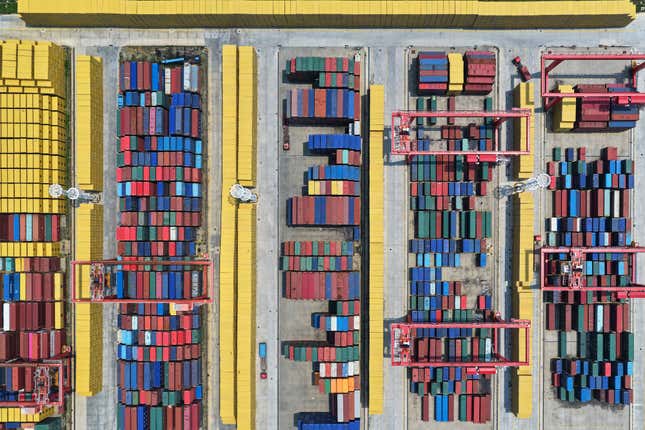
Even as fresh trade talks get underway in London, and despite the trade truce struck in early May, Chinese exports to the U.S. are cratering. Shipments dropped 35% in May, the sharpest year-over-year percentage decline since February 2020.
Excluding that pandemic-era collapse, it’s the steepest drop on record. The figures also mark the first major release of Chinese trade data since the Geneva truce was announced.
China’s overall exports climbed almost 5%, however, as trading partners in the E.U. and other parts of Asia picked up the slack, helping offset the China-U.S. collapse. But that growth still missed expectations, and a deeper concern is brewing at home: China’s imports fell 3.4%, factory-gate prices dropped 3.3%, and consumer prices fell for a fourth straight month.
This suggests that businesses are cutting prices to survive, and that consumers are holding back, too.
Tariffs fell but trade didn’t bounce back
The biggest casualties so far are likely to be Chinese manufacturers, especially smaller firms that rely heavily on U.S. orders and don’t have the resources to quickly pivot to new markets. For such businesses, a 35% drop in U.S.-bound exports can be a death sentence.
U.S. importers and retailers are feeling it too, especially those dependent on Chinese suppliers for items such as electronics, tools, toys, and furniture. Higher prices, delayed shipments, and supply chain gaps or shortages are the likely result. Logistics firms remain exposed, too. Fewer shipments mean lower port traffic, less freight volume, and tighter or even nonexistent margins.
Inside China, the downturn appears to be stoking anxiety at every level of the economy. Despite multiple rounds of monetary easing and public efforts to boost spending, deflation persists. Prices are falling not because of positive developments like efficiency or innovation, but on low demand and brutal competition.
In short, consumers aren’t buying. Businesses aren’t expanding. And policymakers appear to be running out of levers to pull.
Trade officials express confidence but hedge their bets
Public statements ahead of Monday’s trade negotiations in London point to a cautious optimism.
U.S. trade advispr Kevin Hassett has said Washington is open to easing its own export controls (including those on high-demand AI chips) and expects rare earth shipments to resume in volume if talks go well. He has described the U.S. as “absolutely” expecting progress.
China, for its part, has said that rare earth controls don’t target specific countries and aren’t retaliatory, while still insisting on its right to regulate such flows. AI chips and rare earths remain tremendous bargaining chips, and both governments appear keen to extract leverage from their positions without making the first major concession.
The deeper story is one of a trust gap as much as a trade gap, suggesting that resolution may be further off than officials are saying — even as both sides increasingly feel the pain.